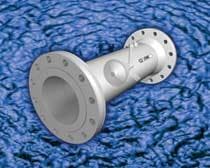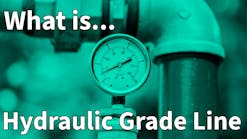McCrometer V-Cone Flow Meter
Click here to enlarge imageSome flow conditioning technologies will perform better in water, clean liquids or gases, as opposed to dirty liquids or slurries with irregular particulates that can cause clogging that requires increased maintenance. Head (pressure) loss is also potential concern, depending on the media, type of conditioner and installation requirements, which can reduce media throughput.
For this reason, a growing number of flow meter manufacturers are focusing on developing flow measurement technologies that offer built-in flow conditioning. This approach offers a number of advantages, including optimized measurement, reduced equipment complexity and lower total installed and operating costs.
One example is, the V-Cone® Flow Meter developed by McCrometer. The meter features a built-in flow conditioner that optimizes measurement accuracy in liquids, steam or gas while reducing the required pipe straight-run by up to 70 percent depending on the application and installation. The meter will be featured in the McCrometer booth at ACE ‘08.
The V-Cone measures flow over a wide range of Reynolds numbers under all kinds of plant environmental conditions and in a variety of clean and dirty fluids. It operates based on the same principle as other differential pressure type flow meters, using the theory of conservation of energy in fluid flow through a pipe.
With its unique design, the meter’s differential-pressure flow technology actually conditions fluid flow to provide a stable flow profile that increases measurement accuracy. The meter’s design features a centrally located cone inside a tube. The cone interacts with the fluid flow and reshapes the fluid’s velocity profile to create a region of lower pressure immediately downstream from itself.
The difference in pressure, which is exhibited between the static line pressure and the low pressure created downstream of the cone, can be measured via two pressure sensing taps. One tap is placed slightly upstream of the cone and the other is located in the downstream face of the cone itself. The pressure difference can then be incorporated into a derivation of the Bernoulli equation to determine the fluid flow rate.
Placing the cone centrally in the line optimizes the velocity of the liquid flow at the point of measurement. It forms very short vortices as the flow passes the cone. These short vortices create a low-amplitude, high-frequency signal for excellent signal stability. The result is a highly stable flow profile for measurement accuracy to +0.5% with +0.1% repeatability over a wide flow range of 10:1. All of this is accomplished with a minimal straight pipe run of only 0 to 3 diameters upstream and 0 to 1 diameters downstream from the cone.
Conclusions
In retrofit or upgrade projects for water/wastewater treatment facilities and other process plants, remember to consider the straight pipe run installation requirement for your flow meters--whether you are leaving them in place or upgrading them. Most flow meter technologies require a straight-run of pipe upstream and downstream from the point of measurement in order to assure a smooth media flow profile.
The addition of new pumps, elbows or valves placed too closely to flow meters may degrade their accuracy and repeatability. Flow conditioners which are built into some flow meters or available as a separate component are a potential solution,. Be sure to consider the properties of the liquid you are flowing before selecting a flow conditioner technology to avoid clogging and/or head (pressure) loss.
Placement of a flow meter with built-in flow conditioning downstream from a pump can be accomplished with a dramatically shorter straight pipe run, reducing installation complexity and costs.
About the Author: Jim Panek is a Senior Member of the Technical Staff at McCrometer. He joined the company in 1982 and has held a variety of positions within the company. He has more than 15 years experience in the water industry and flow instrumentation market.





